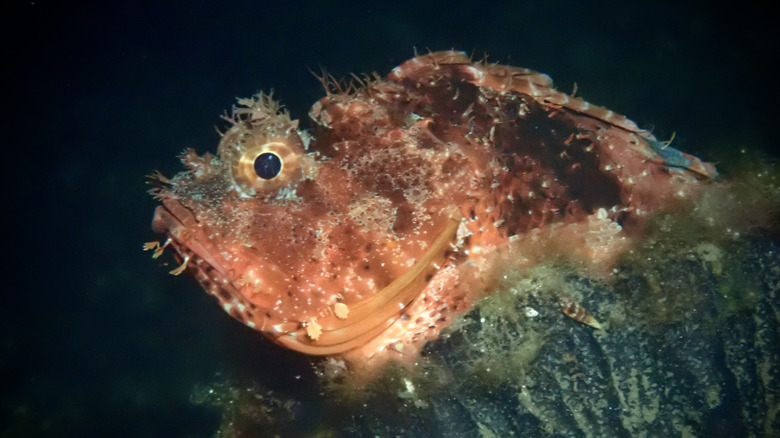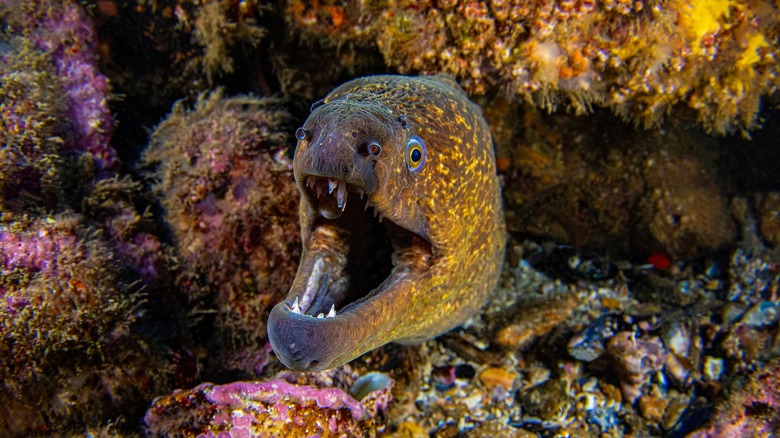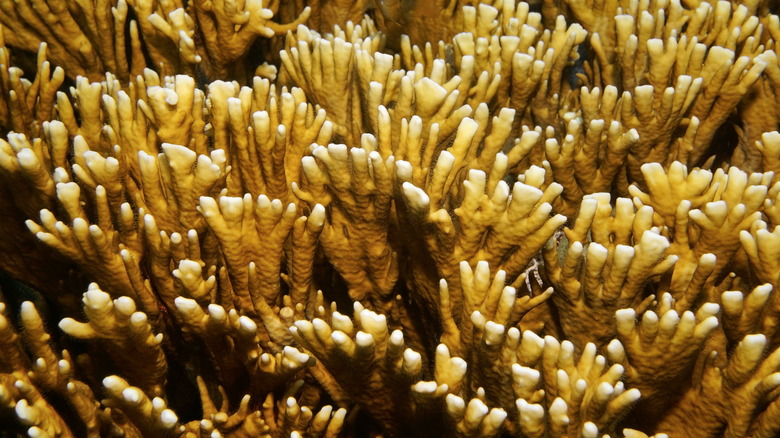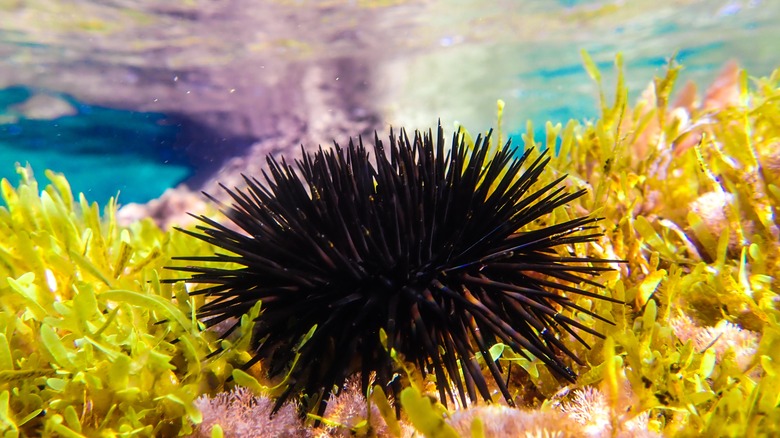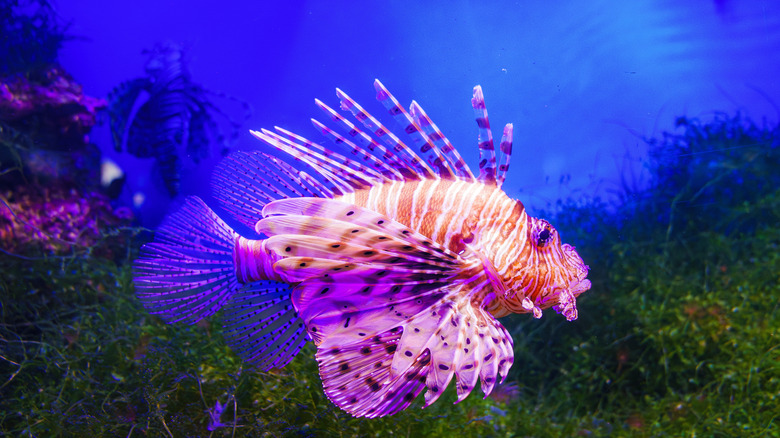Beware Of These Creatures When Swimming At Florida's Gorgeous Beaches
Florida is known for many things. Long stretches of gorgeous beaches rank right near the top of the list. In fact, Florida has over 800 miles of sandy beaches that are frequented by locals and visitors alike. While these long stretches of sand offer plenty of recreational opportunities, like any coastal destinations, there are also some perils. Many of these, such as deadly sharks, various species of dangerous jellyfish, and treacherous stingrays are expected in ocean waters. Actually, Florida leads the nation in shark attacks, so the presence of these potential predators certainly shouldn't come as a surprise to anyone who keeps up with current events.
Although a number of potential risks are well known, there are a number of unexpected beach dangers, as well, along the Florida coastline. Several of these involve creatures living in the waters that lap against the beachfront. Given that Florida is situated at the confluence of three bodies of warm saltwater — the Atlantic Ocean, the Gulf of Mexico, and the Straits of Florida – it is of little surprise there are plenty of creatures to beware of when swimming at Florida's gorgeous beaches beyond just sharks, jellyfish, and stingrays.
Scorpionfish have spines that sting
Florida waters are home to a handful of species of scorpionfish, with the spotted scorpionfish being the most common. This bottom-dwelling species isn't seen all that often — not because they aren't around, but rather because they are rather adept at blending into their surroundings. Scorpionfish tend to hang around reefs and rocky structures where they blend right in. As their name suggests, scorpionfish have a bit of a sting. However, they do not use their toxicity to attack humans. Rather, their sting is a defensive measure which occurs when someone comes in contact with the sharp and venomous spines in their dorsal fin. This typically happens in one of two ways: fishermen handling them after incidentally catching them or snorkelers and swimmers accidentally placing a hand or foot on top of an unseen scorpionfish.
Regardless of how it happens, a prick from a scorpionfish can be extremely painful. The pain can quickly spread up the arm or leg that has been punctured and cause a litany of other issues, including fever, nausea, low blood pressure, rapid heart rate, abdominal pain, and headache. If you are stung by a scorpionfish, rinse the area, then soak the wound in hot water. If you begin developing difficulty breathing or other severe symptoms, promptly seek medical attention.
Moray eels may bite
Moray eels can be mesmerizing, as they are often seen writhing through reefs, jetties, and rocky shorelines. Florida is home to a half dozen varieties of morays, with the green moray being the largest, capable of growing up to eight feet long and weighing over 60 pounds. Regardless of size, all morays are equipped with a mouth full of sharp teeth. Although they do not typically display unwarranted aggression to humans, they will aggressively defend their lair — typically a hole in a reef or rock structure. Most bites on humans occur when either a moray is spotted and a diver or snorkeler attempts to feed it or when a swimmer, diver, or snorkeler accidentally places their hand or foot near the opening to a moray's home.
A bite from a moray eel can be extremely painful. The combination of sharp teeth and powerful jaws can also easily rip flesh. As a result, many moray eel bites result in the need for stitches. Additionally, infection is a very common risk factor following a bite from a moray eel, so medical care is advised for even minor bites. The best way to avoid being bitten is to never attempt to feed a moray and avoid placing your hands in areas where they may be hiding.
Fire coral can cause a burning sensation
Coral reefs can almost be described as underwater flower gardens. They are beautiful and colorful and attract a wide variety of fish and marine life. They also attract plenty of people. Snorkeling and diving are very popular throughout Florida's coastal waters. In addition to the clear waters, both manmade and natural reefs that are sprinkled along the Sunshine State's coastline are a huge draw for snorkelers and divers alike. While those viewing coral reefs are always advised not to touch the coral for the coral's sake, taking a hands-off approach can also save you from a potential painful contact. This is because brushing against a fire coral can leave your skin burning for hours.
Both species found in Florida — branching and bladed — have neurotoxin-ladled barbs. These tiny protrusions are intended for injecting prey such as small fish with an immobilizing dose of toxins. While the toxin of a fire coral isn't typically potent enough to cause such a disabling reaction in humans, they can be painful and potentially worse. Contact stings usually just result in a painful, burning rash. However, if contact with the coral causes a cut or laceration, tissue damage from the toxin and infection are very real concerns. The best way to avoid such an injury is to stay a safe distance from coral, keeping in mind currents and waves may cause you to move a considerable amount in the water.
Sea urchin sport sharp spines
Dozens of species of sea urchins call the waters around the Florida peninsula home. Although sea urchins can't swim and move along the bottom excruciatingly slow, they nonetheless pose a significant risk to swimmers, snorkelers, and divers. This is because most species of sea urchins are completely covered with a series of sharp, protruding spines tipped with small barbs. Since they live in shallow water, often clustered around rocky shorelines or jetties, anyone getting in the water in these areas is likely to encounter them.
While sea urchins are incapable of attacking people, they do nonetheless injure a number of beachgoers each year who unsuspectingly bump against them with their hands, feet, or body. When someone touches, grabs, or steps on the pointy part of these spines, a puncture is likely. Additionally, these spines often break off once they penetrate the skin. Some sea urchin spines contain a toxin, which can increase the level of pain. However, any sea urchin stick has a likelihood of becoming infected if not treated immediately. Removing the spines is of utmost importance. If only a small portion of the spine has broken off in the skin, soaking in vinegar may be sufficient to dissolve it. However, deeper wounds with a larger portion of the spine embedded usually require medical procedures to remove.
Lionfish are beautiful but dangerous
Lionfish have long been recognized as one of the world's most dangerous ocean creatures. However, these beautiful but deadly fish weren't a concern for those swimming in the waters off Florida beaches until the mid-1980s. That's because lionfish aren't native to the Gulf of Mexico, Atlantic Ocean, or the Straits of Florida. According to the Florida Fish and Wildlife Conservation Commission, the first reports of lionfish in Florida waters were in 1985. Since then, the invasive species has become all too common along the entire coastline of the Sunshine State.
Lionfish have been able to rapidly expand throughout these waters because they have no natural predators and most of the native fish have no idea how to handle the nasty and deadly defense mechanism the lionfish utilizes. The 18 spines running along the back of a lionfish, which is incidentally where the name derives as they are said to look like a lion's mane, are full of a potent toxin which is rapidly pumped into any fish, animal, or person unlucky enough to be poked by them. If you happen to encounter a lionfish while in the water, stay a safe distance away. If you happen to hook one while fishing, it is best to use thick gloves when handling the fish. If you are stuck by a lionfish, wash the wound and remove any spines before soaking in hot water. If you develop nausea, fever, faintness, cramping, or are unable to remove the spines, seek medical attention immediately.

